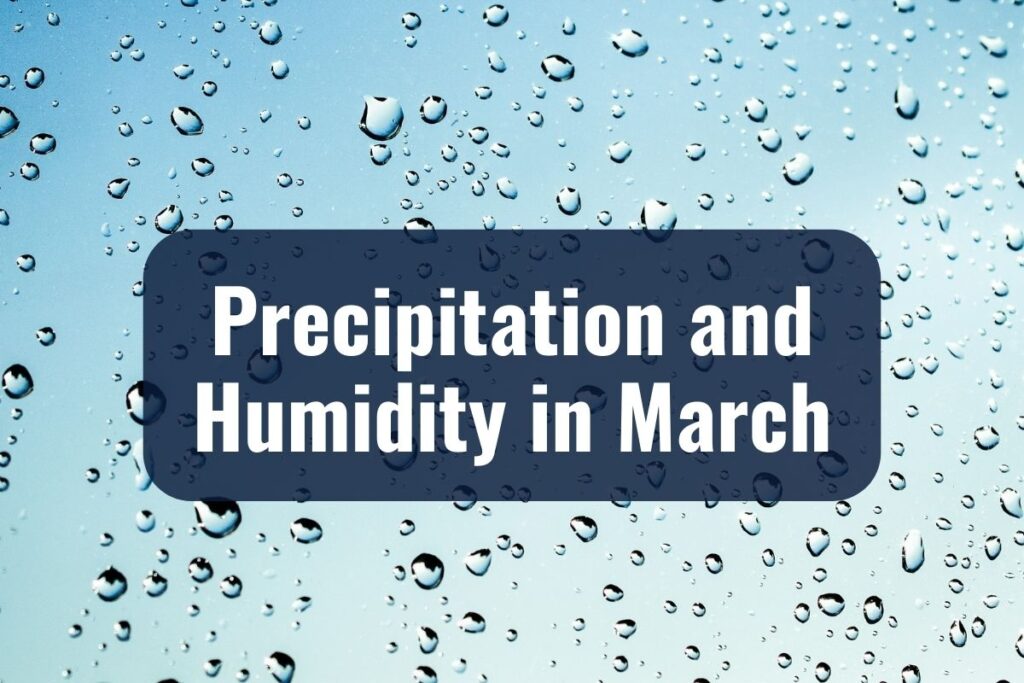When living in or visiting France, understanding the local weather patterns is crucial, especially in transitional months like March. For foreigners, this knowledge can significantly enhance their daily lives, from choosing activities to dressing appropriately.
March in France marks the end of winter and the onset of spring, a period characterized by rapid changes and regional variations in weather. This article aims to provide you with a clear, informative guide to navigating these changes and making the most of your time in France during this month.
KEY TAKEAWAYS
- March Weather is Unpredictable: Prepare for a range of conditions from sunny spells to sudden showers.
- Regional Variations Matter: Weather differs significantly between northern, southern, and coastal France.
- Layered Clothing is Key: Adaptable and layered outfits are essential for the fluctuating March weather.
- Stay Updated: Regularly check local weather apps and websites for the latest forecasts.
- Indoor Alternatives: Have plans for indoor activities to enjoy France’s culture on rainy days.
General Weather Tendencies in March
In March, France begins to shake off the winter chill, welcoming the first signs of spring. However, the weather is often unpredictable, ranging from crisp, sunny days to sudden showers. Temperatures start to rise gradually, but cold snaps are not uncommon.
Understanding these general tendencies is the first step in preparing for what might come your way, whether you’re strolling the streets of Paris or exploring the countryside.
Geographical Overview of France

France’s Diverse Climate Zones
France is a country with a rich tapestry of geographical features, each influencing the local climate in unique ways. From the rugged coasts of Brittany to the sun-drenched beaches of the Riviera, the snowy peaks of the Alps to the rolling vineyards of Bordeaux, the climate can vary dramatically within just a few hours’ drive.
Broadly speaking, France has four main climate zones: the oceanic climate in the west, continental in the center and east, Mediterranean in the south, and a mountain climate in the Alps and Pyrenees. This diversity is crucial for understanding the varying weather patterns you might encounter in March.
Importance of Regional Variations for Weather in March
As March ushers in the transition from winter to spring, the impact of these regional climates becomes even more pronounced. In the north and along the Atlantic coast, you may find milder temperatures and more frequent rains. The central and eastern parts of the country, with a more continental climate, often experience a sharper contrast between day and night temperatures, along with lingering winter chill.
Down south, the Mediterranean areas begin to warm up noticeably, offering milder and sunnier days, though the weather can still be quite variable. In the mountains, while ski season may be winding down, significant snow and cold can persist, affecting both weather conditions and travel plans.
Typical Weather in March
| City | Average Low | Average High |
| Paris | 5°C (41°F) | 12°C (54°F) |
| Lyon | 4°C (39°F) | 13°C (55°F) |
| Nice | 8°C (46°F) | 15°C (59°F) |
| Bordeaux | 6°C (43°F) | 15°C (59°F) |
| Marseille | 9°C (48°F) | 16°C (61°F) |
| Strasbourg | 3°C (37°F) | 12°C (54°F) |
Average Temperatures and Conditions
Northern France
Temperatures: Range from lows of 3°C (37°F) to highs of 10°C (50°F).
Conditions: Expect a mix of cloudy days with occasional sunny spells and rain showers. Late snow flurries are possible but not common.
Southern France
Temperatures: Milder with lows around 6°C (43°F) and highs up to 15°C (59°F).
Conditions: More frequent sunny days, especially along the Mediterranean coast, but still prone to sudden showers.
Western France
Temperatures: Similar to the north, with a slightly milder maritime influence.
Conditions: Oceanic climate brings more consistent cloud cover and precipitation, with the Atlantic coast experiencing windy conditions.
Eastern France
Temperatures: Often cooler, especially at night, with lows near freezing and highs around 10°C (50°F).
Conditions: Clearer skies but with a risk of late winter cold snaps and occasional snow, particularly in areas close to the mountains.
Coastal vs. Inland Areas
Coastal Areas:
- Generally milder due to the maritime influence.
- Windier conditions, especially along the northern and western coasts.
- The Mediterranean coast sees warmer temperatures and is often a preferred destination for early spring.
Inland Areas:
- Greater temperature variations between day and night.
- More likelihood of frost and fog, especially in the mornings.
- In regions like the Loire Valley or Alsace, expect clearer skies but prepare for crisp mornings.
Regional Highlights
Paris and the Île-de-France: Variable with frequent changes; mild days can quickly turn chilly or rainy.
The Rhône Valley: Known for the Mistral wind which can bring sudden cold and clear skies.
The French Alps: Still in the tail end of ski season with cooler temperatures and possible snowfall, especially at higher altitudes.
Provence and the French Riviera: Early signs of the warm and pleasant Mediterranean climate with less rain and more sunny days.
Precipitation and Humidity in March

Average Rainfall/Snowfall Across Different Regions
Northern France
Rainfall: On average, expect moderate rainfall with Paris and surrounding areas receiving up to 50mm over the month.
Snowfall: Snow is rare but not impossible, particularly in the early days of March or at higher elevations.
Southern France
Rainfall: Generally lighter than in the north, with Mediterranean areas seeing less frequent but sometimes heavier showers.
Snowfall: Mostly confined to the mountainous areas like the Pyrenees, with coastal areas rarely experiencing snow.
Western France
Rainfall: Consistent rainfall due to the Atlantic influence, with places like Brittany experiencing wetter conditions.
Snowfall: Snow is uncommon, especially along the coast.
Eastern France
Rainfall: Varied, with some areas seeing significant rain, particularly as you move towards the Alpine regions.
Snowfall: More common in the Alps and other elevated areas, though generally starting to lessen in March.
Humidity Variations in March
Overall Humidity Levels: Humidity in France during March can vary widely depending on the region and prevailing weather patterns. Generally, expect higher humidity in the coastal and northern regions and lower humidity in the south and east.
Impact on Daily Life: In areas with higher humidity and cooler temperatures, mornings can be misty with a chill in the air. In drier areas, especially when the sun is out, the air can feel quite comfortable, even as temperatures remain moderate.
Rain Gear: No matter where you are in France during March, it’s wise to carry an umbrella or waterproof jacket. Sudden showers are common.
Layering: Due to the variable humidity and temperatures, dressing in layers can help you stay comfortable throughout the day.
Indoor Humidity: If you’re staying in older buildings or areas with higher humidity, be mindful of indoor air quality and comfort. Heating systems might still be running, affecting indoor humidity levels.
Winds and Weather Systems
Common Winds in March
Mistral Wind
A cold, dry wind can be experienced primarily in the Rhône Valley and Provence. It is known for its strength and ability to clear skies but can significantly lower temperatures.
Tramontane Wind
Similar to the Mistral, this affects the western Mediterranean region, particularly Languedoc and Roussillon. It’s a dry, sometimes strong wind coming from the northwest.
Marine Influences
Coastal areas, especially in the north and west, frequently experience breezes and stronger winds coming off the Atlantic Ocean.
Effects of Winds on March Weather
Temperature Variations: Winds like the Mistral can cause sudden drops in temperature, especially noticeable in the southern regions.
Clearing Skies: These winds often blow away cloud cover, leading to sunny, clear days, particularly in the south.
Sea Conditions: For coastal regions, winds can lead to rough seas and affect ferry travel or coastal activities.
Prevailing Weather Systems
High-Pressure Systems: Often bring settled weather with clearer skies and milder temperatures, typical in the transition towards spring.
Low-Pressure Systems: This can lead to more unsettled weather, including rain and wind, especially coming from the Atlantic.
Preparing for March Winds and Weather Systems
Clothing: Wind-resistant clothing is advisable, especially in areas known for strong winds like the Rhône Valley.
Activities: Be aware that wind conditions might affect outdoor plans, from city walks to countryside hikes.
Travel: Check forecasts regularly, as winds can impact travel, especially if you’re planning to visit islands or coastal areas.
What to Expect in Major Cities and Tourist Destinations

Paris and Île-de-France
Weather: March sees a gradual increase in temperatures, with averages between 5°C (41°F) and 12°C (54°F). The city experiences a mix of rain, cloudy days, and occasional sunny spells.
What to Expect: The weather can change rapidly, so it’s wise to be prepared for a bit of everything. Outdoor cafes begin to open, and the first blooms in parks signal spring’s arrival.
Lyon
Weather: Temperatures range from 4°C (39°F) to 13°C (55°F). Expect a mix of sunny and rainy days, with occasional winds influencing the weather.
What to Expect: As a major city near the Alps, weather can be variable. Enjoy the city’s gastronomy and indoor attractions like museums on rainy days.
Nice and the French Riviera
Weather: Milder with temperatures from 8°C (46°F) to 15°C (59°F). Less rain and more sunny days as the Mediterranean climate starts to show.
What to Expect: The seaside promenades and cafes become more lively, and it’s an excellent time for coastal walks or exploring nearby villages.
Bordeaux
Weather: Similar to Paris but slightly warmer, with temperatures ranging from 6°C (43°F) to 15°C (59°F). Expect a mix of sun and rain, with the Atlantic influence bringing moisture.
What to Expect: The city and surrounding wine country can be quite pleasant with fewer tourists and mild weather, perfect for exploring both urban and rural settings.
Marseille
Weather: Early signs of warmer Mediterranean weather with temperatures between 9°C (48°F) and 16°C (61°F). Sunny days are more common, but windy conditions can persist.
What to Expect: Enjoy outdoor markets and the old port area as the city begins to warm up. The calanques (rocky inlets) near the city are particularly beautiful in the milder weather.
Strasbourg and the Alsace Region
Weather: Cooler due to its proximity to the Rhine and the mountains, with temperatures from 3°C (37°F) to 12°C (54°F). A mix of clear and cloudy days with less rain.
What to Expect: The city’s charming streets and outdoor markets are enjoyable in the crisp weather. The region’s famous white wines and hearty cuisine are particularly inviting during the cooler days of March.
Tips for Visiting in March
Layering is Key: The variable weather across these cities and regions means that dressing in layers will allow you to adapt comfortably as the day progresses.
Check Local Weather Daily: Conditions can change quickly, especially in transitional seasons like March. Stay updated with local forecasts.
Indoor Alternatives: Have a plan for indoor activities like museums, cafes, or shopping, especially in cities where rain might affect your outdoor plans.
Clothing and Packing Advice for March
March in France is characterized by its transitional weather, often fluctuating between the tail end of the winter chill and the early whispers of spring warmth. As such, packing requires a thoughtful approach to handle the variability comfortably. Here are some tips on how to pack for your visit to France during this month.
Layering is Essential
Base Layer: Start with a moisture-wicking base layer, especially if you plan on being active or walking around a lot. This will keep you dry and comfortable.
Mid Layer: Add a warm mid-layer such as a fleece or a wool sweater. This layer is crucial for retaining heat on cooler days.
Outer Layer: Your outer layer should be a waterproof and windproof jacket. Even if it isn’t raining, a good jacket can protect against the wind, which is often chilly in March.
Adaptable Clothing Items
Pants: Bring along a pair of comfortable, durable pants. Jeans are versatile, but you might also consider water-resistant trousers if you’re heading to wetter regions or planning outdoor activities.
Shirts: Pack long-sleeve shirts for layering and a few short-sleeved ones for the occasional warm day.
Dresses/Skirts: For those who prefer them, include a couple of dresses or skirts that can be layered with leggings or tights.
Footwear
Shoes: Waterproof or water-resistant shoes are a good idea due to the unpredictable rain showers. Comfortable walking shoes or boots are essential for exploring cities or the countryside.
Socks: Wool or wool-blend socks will keep your feet warm and dry, especially important if you’re doing a lot of walking.
Accessories
Scarves, Hats, and Gloves: A warm scarf, hat, and gloves can be vital for early morning and evening outings when the temperature can drop significantly.
Umbrella: A compact, sturdy umbrella will be invaluable against March showers.
Sunglasses: Don’t forget sunglasses for those surprisingly sunny March days, especially in the south of France.
Special Considerations
Evening Wear: If you plan on dining out or attending events, include a smart casual outfit. Evenings can still be quite cool, so an elegant shawl or jacket is advisable.
Health and Comfort: Pack any necessary medications and skincare items to stay comfortable, considering the changing weather might affect your skin or health.
Health and Comfort Tips

March in France brings a transitional and often unpredictable climate, which can impact your health and comfort if you’re not prepared. Here are some practical tips to ensure you stay healthy and comfortable during your visit.
Dealing with Variable Weather
Stay Hydrated: Changing temperatures and indoor heating can dehydrate you more than you might expect. Carry a water bottle and drink regularly.
Skin Care: The fluctuating weather can affect your skin. Use a good moisturizer to combat dryness, and always have lip balm handy. On sunny days, don’t forget to apply sunscreen, especially if you’re at higher altitudes or in southern regions.
Allergies: March can start the early pollen season, particularly in warmer areas. If you’re prone to allergies, bring appropriate medication and check the local pollen forecast.
Maintaining Comfort
Warmth and Circulation: On cooler days, make sure to keep your extremities warm to maintain good circulation. Gloves, warm socks, and hats are important.
Rest and Sleep: Traveling can disrupt your sleep patterns, especially when dealing with time zone changes or a busy itinerary. Ensure you get enough rest to fully enjoy your days exploring.
Indoor Air Quality: If you’re staying indoors more due to cooler weather, ensure the place is well-ventilated. This is particularly important in older buildings or accommodations with central heating.
Preparing for Outdoor Activities
Appropriate Gear: If you plan to engage in outdoor activities like hiking or city walking tours, ensure you have the appropriate gear, including waterproof and comfortable footwear.
Weather Awareness: Keep an eye on the daily weather forecast and be prepared to adjust your plans accordingly. Sudden weather changes can occur, especially in mountainous or coastal regions.
Diet and Nutrition
Balanced Diet: Enjoy the rich culinary offerings of France, but also ensure you’re eating a balanced diet with enough fruits and vegetables. This is important for maintaining energy levels and overall health.
Local Water: Tap water in France is generally safe to drink, but if you’re unsure or have a sensitive stomach, opt for bottled water, especially in rural or coastal areas.
Understanding French Weather Terms
Having a basic understanding of French weather vocabulary can be very helpful, especially if you’re using local resources or find yourself in a situation where you need to discuss the weather. Terms like “pluie” (rain), “nuageux” (cloudy), “vent” (wind), and “ensoleillé” (sunny) can be a good starting point.
Tips for Using Weather Resources
Check Regularly: Weather can change quickly, especially in spring. Check the forecast regularly, ideally each morning, to plan your day.
Local vs. General Forecasts: For the most accurate information, look at local forecasts for the area you’re visiting, as weather can vary significantly between regions.
Plan Flexibly: Allow some flexibility in your plans to accommodate unexpected weather changes.
Useful Resources and Apps for Weather Updates
Météo-France: The official app of the French National Meteorological Service provides detailed local forecasts across the country.
AccuWeather: A popular global weather app known for its accuracy and detailed forecasts, including minute-by-minute precipitation updates.
WeatherPro: Offers reliable weather reports and radar images, particularly useful for planning outdoor activities.
BBC Weather: Provides a simple and clear forecast for cities across France, often including helpful commentary on the expected conditions.
The Weather Channel (weather.com): Offers detailed forecasts, including hourly and 10-day options, with interactive maps and videos.
France 24 and Local News Channels: Keep updated with local news channels or France 24 for weather alerts and forecasts in English.
Radio Stations: Tuning into local radio stations can also provide timely updates and advice, particularly in regions prone to sudden weather changes.


